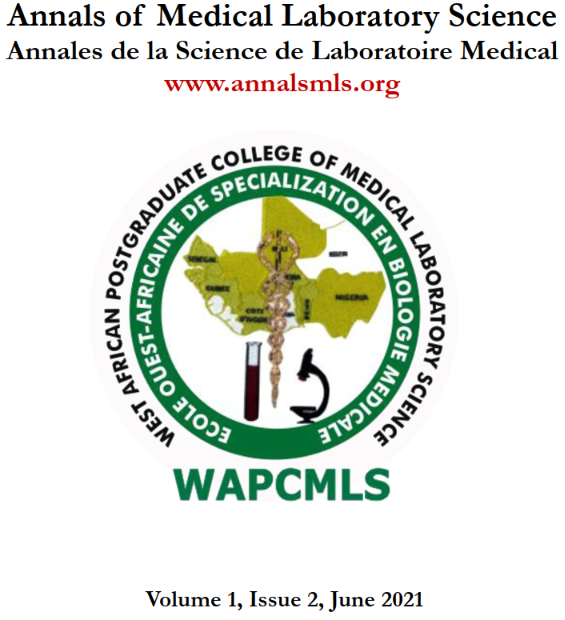A comparative study of glycaemic variability using four different Point-of-Care Testing (POCT) devices
Abstract
Background: Blood glucose measurement is a way of monitoring changes in glycaemia. Different point-of-care testing (POCT) glucose meters are on the market and hence there is an increase in variability of the results given by these meters. This study sought to measure the glycaemic variability using four different point-of-care glucose meters
Methods: Four point of care glucometers namely; Accu-chek performer nano, OneTouch select plus flex, OneTouch Ultra 2 and Easy Check were used test blood samples from a total of 100 patients visiting the collection point of the Tamale Teaching Hospital Laboratory. A chemistry analyzer (Mindray BS 240 fully automated) was used as the reference method.
Results: The median (interquartile range), Bland Altman Plot and Regression Equation were used to assess the agreement between the various meters and the reference method. The OneTouch Select plus had the least bias (-0.85) and the the OneTouch Ultra 2 had the highest bias (1.49). The OneTouch select had
the best limits of agreement (-2.51 – 0.82) and the OneTouch Ultra 2 had the widest limits of agreement (-1.91 – 4.89) when compared to the reference
method.
Conclusion: OneTouch Select plus had the best agreement with the reference method and the OneTouch Ultra 2 had the least agreement with the reference method. Blood glucose meters should be used for the monitoring of blood glucose however, it should not be used as a diagnostic tool.
Annals of Medical Laboratory Science (2021) 1(2), 1 - 8
References
Cohen M., Boyle E., Delaney C. and Shaw J. (2006) A comparison of blood glucose meters in Australia. Diabetes research and clinical practice 71(2), 113-118.
Dungan K., Chapman J., Braithwaite S.S. and Buse J. (2007) Glucose measurement: confounding issues in setting targets for inpatient management. Diabetes care 30(2), 403-409.
Ekhlaspour L., Mondesir D., Lautsch N., Balliro C., Hillard M., Magyar K., Radocchia L.G., Esmaeili A., Snha M. and Russell S.J. (2017) Comparative accuracy of 17 point-of-care glucose meters. Journal of diabetes science and technology 11(3), 558-566.
Essack Y., Hoffman M., Rensburg M., Van Wyk J., Meyer C. and Erasmus R. (2009) A comparison of five glucometers in South Africa. Journal of Endocrinology, Metabolism and Diabetes of South Africa 14(2), 102-105.
Freckmann G., Baumstark A., Jendrike N., Zschornack E., Kocher S., Tshiananga J., Heister F. and Haug C. (2010) System accuracy evaluation of 27 blood glucose monitoring systems according to DIN EN ISO 15197. Diabetes technology & therapeutics 12(3), 221-231.
Hellman R. (2012) Glycemic variability in the use of point-of-care glucose meters. Diabetes Spectrum 25(3), 135-140. Hughes M.D. (2009) The business of self-monitoring of blood glucose: a market profile. Journal of diabetes science and technology 3(5), 1219-1223.
Kiechle F.L. and Main R.I. (2000) Blood glucose: measurement in the point-of-care setting. Laboratory Medicine 31(5), 276-282.
Klonoff D.C. (2014) Point-of-care blood glucose meter accuracy in the hospital setting. Diabetes Spectrum 27(3), 174-179.
Kristensen G.B., Nerhus K., Thue G. and Sandberg S. (2006) Results and feasibility of an external quality assessment scheme for self-monitoring of blood glucose. Clinical chemistry 52(7), 1311-1317.
Marshall W. (2012) Glucose (blood, Serum, Plasma). In Clinical Biochemistry.
Poirier J.-Y., Le Prieur N., Campion L., Guilhem I., Allannic H. and Maugendre D. (1998) Clinical and statistical evaluation of self-monitoring blood glucose meters. Diabetes Care 21(11), 1919-1924.
Rajendran R. and Rayman G. (2014) Point-of-care blood glucose testing for diabetes care in hospitalized patients: an evidence-based review. Journal of diabetes science and technology 8(6), 1081-1090.
As AMLS is an international Open Access magazine, all the articles published under this journal will be accessible to all internet users throughout the world without any barrier of access under the terms of the Creative Commons Attribution License. The copyright of a submitted article is only transferred to the publishers if and when the article is accepted for publication.

